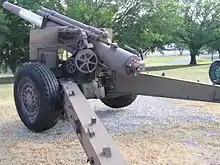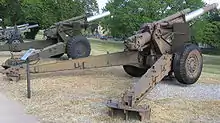4.5-inch gun M1
The 4.5 inch gun M1 was a field gun developed in the United States in the beginning of World War II. It shared the same carriage with the 155mm Howitzer M1 and fired the same ammunition as the British BL 4.5 inch Medium Field Gun. The weapon was used by the US Army in Northwest Europe late in the war for corps support; with the end of hostilities it was declared obsolete.
| 4.5 inch gun M1 on carriage M1 | |
|---|---|
 | |
| Type | Field gun |
| Place of origin | United States |
| Service history | |
| In service | 1942–1945 |
| Used by | United States |
| Wars | WWII |
| Production history | |
| Designed | 1939–1941 |
| Produced | September 1942–February 1944 |
| No. built | 426 |
| Specifications | |
| Mass | 5,654 kg (12,465 lbs) |
| Length | 8.15 m (27 ft) |
| Barrel length | Bore: 4.756 m (15 ft 7 in) L/41.6 Overall: 4.918 m (16 ft 2 in) L/43 |
| Width | 2.4 m (7 ft 10 in) |
| Height | 2.12 m (6 ft 11 in) |
| Shell | separate-loading bagged charge |
| Caliber | 114 mm / 4.5 inch |
| Breech | interrupted screw |
| Recoil | hydro-pneumatic |
| Carriage | split trail |
| Elevation | 0° to +65° |
| Traverse | 53° |
| Rate of fire | Burst: 4 rounds per minute Sustained: 1 round per minute |
| Muzzle velocity | 693 m/s (2,274 ft/s) |
| Maximum firing range | 19,317 m (21,125 yds) |
| Sights | panoramic, M12 |
Development and production
In 1920 the US Army Ordnance started to work on a new medium field gun. Since the US Army had already employed the 4.7 inch gun M1906 during World War I, this caliber was also selected for the new weapon. The development resulted in 4.7 inch gun M1922E on Carriage M1921E. Due to lack of funding, the design never reached production.[1][2]
In 1939 the program was restarted; the renewed design, designated 4.7 inch gun T3, was ready by early 1940; it utilized the same carriage as the concurrently developed 155 mm howitzer. At this stage, the army decided to change the weapon to use the British 4.5 inch ammunition. The modified gun was standardized in April 1941 as 4.5 inch gun M1 on carriage M1.[1][2]
The production started in September 1942 and continued until February 1944.[2]
| Production of M1[3] [4] | |||||||||||
| Year | 1942 | 1943 | 1944 | Total | |||||||
| Produced, pcs. | 41 | 345 | 40 | 426 | |||||||
Description
The M1 was very similar in construction and appearance to the 155mm Howitzer M1. The only significant difference was its tube of 4.5 inch (114 mm) caliber. The tube had uniform right hand twist, with one turn in 32 calibers.[5] The unbalanced weight of the barrel was supported by two equilibrator springs. The breach was of interrupted screw type; the recoil system hydro-pneumatic, variable length. The carriage was of split trail type, unsprung and had wheels with pneumatic tires. In firing position, the weapon was supported by a retractable pedestal. The gun was equipped with M12 panoramic sight.[6]
Service
The M1 equipped 17[7] field artillery battalions in Northwest Europe, where it was employed for corps support. M5 High Speed Tractor was assigned as prime mover. The weapon was declared obsolete in September 1945.[1][2]
US Army field artillery battalions armed with the 4.5-inch gun included at least: 172nd, 176th, 199th, 211th, 259th, 770th through 775th, 777th, 935th, 939th, 941st, and 959th.[8]
The gun had good range, nearly five km longer than its 155 mm howitzer sibling and longer than the 155 mm Gun M1918MI. It was out-ranged by another 155 mm gun, the 155 mm Gun M1, but the latter was nearly three times heavier.
On the other side, the 4.5 inch gun was criticized for insufficient power of its high-explosive shell. The shell was produced from low grade ("19 ton") steel, which necessitated thick walls. As a result, it carried only about two kg of TNT or substitute, in fact less than the 105 mm high-explosive shell. Additionally, it was felt that having a small number of guns of atypical caliber unnecessarily complicated logistics.[1][2]
Variants
| External image | |
|---|---|
- 4.7 inch Gun M1920 on Carriage M1920.[2]
- 4.7 inch Gun M1922E on Carriage M1921E.[2]
- 4.7 inch Gun T3 (1940).[2]
- 4.5 inch Gun M1 on Carriage M1 (1941).[1]
The weapon was experimentally mounted on a lengthened chassis of the M5 light tank, in mount M1. The resulting vehicle received the designation 4.5in Gun Motor Carriage T16. A single prototype was built.[9]
Ammunition
The M1 utilized separate loading, bagged charge ammunition. Only high explosive projectile was available.[10]
The projectile could be fired with propelling charge M7 (normal) at reduced velocity or with propelling charge M8 (super) to achieve full velocity. The dummy propelling charge M6 simulated the M8 charge.[11] The velocity and range data in the table below is for the M8 charge.
| Available ammunition.[5][10][12] | |||||
| Type | Model | Projectile weight, kg | Filler | Muzzle velocity, m/s | Range, m |
| HE | HE M65 Shell | 24.9 | TNT, 2.04 kg or Amatol 50/50, 1.85 kg or Trimonite, 2.10 kg |
693 | 19,317 |
| Dummy | Dummy M8 Projectile | - | - | ||
| Propelling charges[11] | ||
| Model | Weight, complete, kg | Components |
| M7 (normal) | 2.95 | Single section |
| M8 (super) | 5.08 | Base charge and increment |
| M6 (dummy) | 5.40 | Base charge and increment |
| Concrete penetration, mm[5] | ||||
| Ammunition \ Distance, m | 0 | 914 | 4,572 | 9,144 |
| HE M65 Shell (meet angle 0°) | 1,158 | 1,067 | 640 | 366 |
| Different methods of measurement were used in different countries / periods. Therefore, direct comparison is often impossible. | ||||
See also
- Field artillery
- List of U.S. Army weapons by supply catalog designation – Item C38
- BL 4.5-inch Medium Field Gun – British weapon using same ammunition
Notes
- Hogg – Allied Artillery of World War II, p 50-51.
- Zaloga – US Field Artillery of World War II, p 18-19.
- Zaloga – US Field Artillery of World War II, p 9.
- Official Munitions Production of the United States, by Months, July 1, 1940 – August 31, 1945 (War Production Board and Civilian Production Administration, 1 May 1947) p. 137
- Hunnicutt – Stuart: A History of the American Light Tank, p 506.
- Technical Manual TM 9-2005 volume 3, Infantry and Cavalry Accompanying Weapons, p 59-62.
- Anderson – US Army in World War II.
- Stanton, Shelby L. (1991). World War II Order of Battle. Galahad Books. pp. 393–424. ISBN 0-88365-775-9.
- Hunnicutt – Stuart: A History of the American Light Tank, p 337-338.
- Technical Manual TM 9-1904, Ammunition Inspection Guide, p 486-490.
- Technical Manual TM 9-1901, Artillery Ammunition, p 300-304.
- Technical Manual TM 9-1901, Artillery Ammunition, p 183-184.
References
| Wikimedia Commons has media related to 4.5 inch Gun M1. |
- Hogg, Ian V. (1998). Allied Artillery of World War Two. Crowood Press, Ramsbury. ISBN 1-86126-165-9.
- Hunnicutt, R. P. (1992). Stuart: A History of the American Light Tank. Presidio Press. ISBN 0-89141-462-2.
- Williford, Glen M (2016). American Breechloading Mobile Artillery 1875-1953. Thomas D. Batha. Schiffer Publishing Ltd. ISBN 978-0-7643-5049-8.
- Zaloga, Steven J. (2007). US Field Artillery of World War II. New Vanguard 131. illustrated by Brian Delf. Osprey Publishing. ISBN 978-1-84603-061-1.
- Technical Manual TM 9-1901, Artillery Ammunition. War Department, 1944.
- Technical Manual TM 9-1904, Ammunition Inspection Guide. War Department, 1944.
- Technical Manual TM 9-2005 volume 3, Infantry and Cavalry Accompanying Weapons. War Department, 1942.
- Technical Manual TM 9-328 4.5-inch Gun M1 and 4.5-inch Gun Carriage M1. War Department. December 1943.
- "Anderson, Rich – US Army in World War II at MilitaryHistoryOnline website". Archived from the original on 14 December 2007. Retrieved 20 November 2007.
